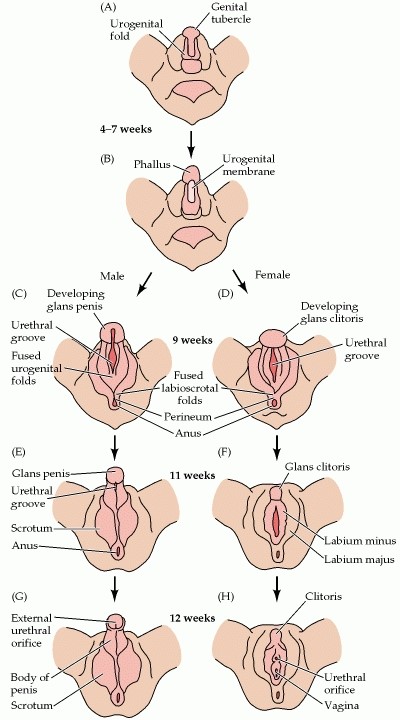8.6 Human Sex Differentiation
In this section, we will expand on both sex determination and sex differentiation, but focus on humans. Essentially, our focus is the proximate (mechanistic) explanation for why an individual has certain sex-related characteristics and not others.
For the first seven weeks of development all human fetuses start the same, no matter their eventual biological sex characteristics. This means that the external and internal genitalia for females and males have the same tissue foundation (see the top image for Figures 8.22 and 8.23). Notice that all humans have the internal and external structures needed to form either male or female reproductive organs.


For example, in the top image for Figure 8.22, you’ll see the Müllerian ducts and Wolffian ducts found in all human fetuses between 4-7 weeks. As development continues, the Müllerian ducts could either become the oviducts and uterus (right side) or they degrade (left side), depending on the signals in that individual.
Point to Ponder
In Section 8.3 you learned that female spotted hyenas have an enlarged clitoris that resembles a penis. The urethra and vagina exit through this structure. Look at Figure 8.23, do you think this structure is a penis or a pseudo-penis?
As a reminder from Section 8.5, humans have a chromosomal sex determination system that utilizes X and Y chromosomes. Most Y chromosomes have a gene called SRY, which is typically not present on the X chromosome. Shortly after the seventh week the SRY gene, if present, begins to be transcribed and translated into a protein called testicular determining factor (TDF).

The function of TDF is to bind to and turn ON transcription of several genes that promote the development of testes. TDF also binds to and turns OFF the transcription of several genes that promote the development of ovaries. The new testes begin to produce testosterone. This increase in testosterone combined with other signals ultimately result in the Wolffian ducts differentiating into the epididymis and vas deferens while the Müllerian ducts degrades (Figure 8.22 left side).
In the absence of the SRY gene and its protein TDF, the ovary-promoting genes will be ON and the testes-promoting genes will be OFF. This will result in the Müllerian ducts differentiating into the oviducts and uterus while the Wolffian ducts degrade (Figure 8.22 right side).
Reproductive anatomy and hormones will be discussed further in Chapter 13.
Explore More
Check Yourself
Using the information in this section challenge yourself to answer the following questions. If you aren’t sure or get it wrong at first then it is a great time to go back and re-read the section or reach out to a classmate, TA, or instructor for help!
- Image "Sexual Differentiation" from OpenStax. Shared with CC-BY 3.0 license. ↵
- Image from Purves D, Augustine GJ, Fitzpatrick D, et al., editors. Neuroscience. 2nd edition. Sunderland (MA): Sinauer Associates; 2001. What Is Sex? ↵
- Image by: Dr. Luca Comai at UC Davis. Personal permission given for use in this text. ↵

